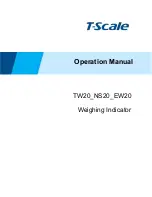
Limitless™ WPMM Series
Issue 2
50051864
Honeywell Sensing and Control 11
ATTENTION
If using the WPMM in a portable application (for example, the WPMM is used in a handheld device
and the antenna is less than 20 cm from the human body when the device is in operation): The
integrator is responsible for passing additional SAR (Specific Absorption Rate) testing based on FCC
rules 2.1091 and FCC Guidelines for Human Exposure to Radio Frequency Electromagnetic Fields,
OET Bulletin and Supplement C. The testing results will be submitted to the FCC for approval prior to
selling the integrated unit. The required SAR testing measures emissions from the module and how
they affect the person.
Notes for Table 11:
1.
Antennas listed in this chart are approved for use with the Digi International XBee –PRO
®
RF Module which
the WPMM utilizes.
2.
The following shall apply for antenna type, frequency range, application/usage and agency/country
compliance:
•
Antenna gains above the maximum values shown shall not be used.
•
Cable length/loss below the minimum values shown shall not be used.
•
Maximum overall radio output power shown shall not be exceeded.
•
Maximum EIRP values shown above shall not be exceeded.
3.
Industry Canada Compliance Statement: This device has been designed to operate with the antenna types
listed in this document, and having a maximum gain of 9 dBi. Antenna types not included in this list or
having a gain greater than 9 dBi are strictly prohibited for use with this device. The required antenna
impedance is 50 Ohm.
5
QUICK START UP
5.1
Antenna Connection
WARNING
RF EXPOSURE
*
To satisfy FCC RF exposure requirements for mobile transmitting devices, a separation distance of 20 cm
[7.87 in] or more should be maintained between the antenna of this device and persons during device
operation To ensure compliance, operation at closer than this distance is not recommended. The antenna
used for this transmission must not be co-located in conjunction with any other antenna or transmitter.
Failure to comply with these instructions could result in death or serious injury.
CAUTION
*
Power to the WPMM should not be applied (ensure battery is removed) during installation of antenna as
damage could occur to the WPMM electronics.
The antenna and antenna guard are packaged separately and thus will need to be assembled to the WPMM.
A
direct mount antenna
(either straight or tilt & swivel) can be easily mounted by threading the mating RP-SMA
plug of the antenna to the RP-SMA jack on the WPMM. Tighten the connection until finger tight. Then, attach the
antenna guard by simply threading the guard finger tight onto the threaded base with the RP-SMA connector
.
A
remote mount antenna
requires the use of an extension cable to allow the antenna to be mounted in a different
location than the WPMM location. The extension cable will need to have one end with a RP-SMA plug connector
which will mate with the WPMM connector jack under the same mounting procedure as the direct mount antenna.
The other end of the extension cable will need to mate with antenna connector directly.
Refer to Section 7.3 for further information regarding installation.
















































